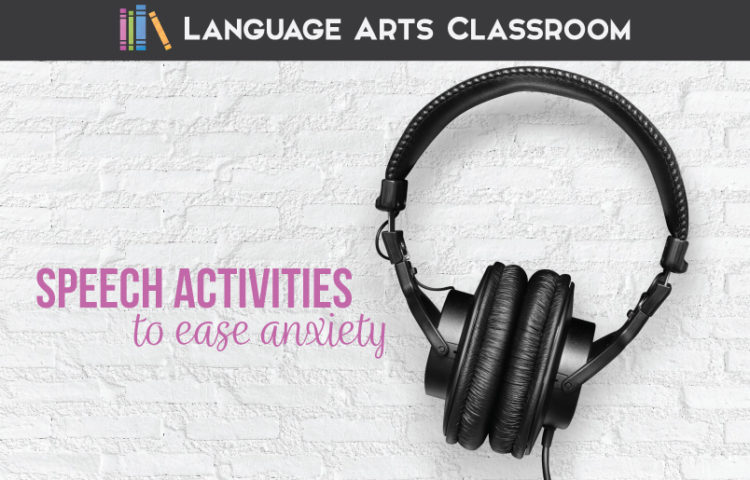Helping public speaking students with anxiety can be done!
I am accustomed to having a public speaking class or specific speech units embedded within a class. These past few years, with the addition of standards, I’ve woven activities into other components of language arts.
Speaking and listening standards exist for every grade. With these requirements, I’ve developed activities that will work in most classes to ease nerves. As teachers, we must acknowledge and hopefully help public speaking students with anxiety.
No matter your approach (class, unit, integration), you can take these four ideas and use them to help nervous presenters.
Working with learners in a variety of areas can address nerves and prevent the running from the classroom. (I’ve had that happen.) With a small bit of planning, we secondary teachers can help our students with speech anxiety.
Here are four ways for helping public speaking students with anxiety.
Focus on presenting, not reading
First, I get it, really. Before I present at a conference or in front of colleagues, I get sweaty hands and shaky knees. Everyone is staring at me. I’ve made this beautiful presentation, why not focus on that? Could I just read? Therefore, I share my personal anxiety idea with my classes. Very few people are completely immune from nerves with public speaking, and the temptation to read is there.
Second, when high school public speaking students know their material, they are likely to succeed at speeches. Speakers should become mini-experts on their content. Will the actual speech be the same as the outline? No! Boost their confidence that their knowledge will make them successful speakers.
Third, to counteract the belief that giving a speech is reading an outline, I read (yes, read) students a presentation about engaging their audience. The presentation is goofy, but giving a terrible presentation to classes is a powerful tool in starting conversations. Plus, the lesson you’ll teach is in complete contrast to the delivery. It’s terrible!
By performing such an awful speech, students are able to laugh and understand my point. We build a compassionate community and provide encouragement to each other.
Finally, to close, discuss why people read from a Powerpoint (fear of public speaking, negative thoughts, overall nervousness). Then brainstorm how to prepare well enough so they don’t rely on the visual aid.
Think on your feet
Additionally, I work on impromptu speaking throughout the year to show students that speaking extemporaneous additions can help a delivery. No matter your subject material, students should be able to respond coherently and clearly. Public speaking with students will naturally include impromptu speaking. (Download those activities for free.) Cut the slips of paper and ask students to draw a topic. Learners should realize that most speaking in real life is a version of impromptu speaking.
Since impromptu speeches are short, let everyone choose where they should improve: adding positive thoughts? attempting eye contact? managing deep breaths before reaching the podium?
Additionally, a quick way to add an element of public speaking is to give a mini-lesson on organizing thoughts in your head and presenting them coherently. That free download even includes a rubric, making the process quick. Whatever topic you study in class, add a quick element of impromptu speaking.
Analyze audience
Not only should students practice public speaking, but they should also be aware of public speaking as audience members. Videos, commercials, and social media bombard our learners with material that they should know how to navigate. What videos specifically target students? Also, what is manipulative? Plus, what should they question? (Lots of questions for audience members!) By looking at public speaking as audience members, you are emphasizing that everyone has a role. Establishing that ideas with classmates then establishes public speaking activities as a cooperative endeavor: Everyone has a job.
Be compassionate with young audiences! Teenagers might not understand the depth in which they are targeted—that the videos were made specifically with their interests and beliefs in mind. Teach students about audience analysis. This media literacy lesson helps with everyone as the speaker and an audience member. Both parts of an audience matter. Remind classes before speeches begin that every class member is actively participating, either as a speaker or audience member.
Finally, when students own knowledge about their audience, they are empowered. Show them that knowing about an audience both targets their message and prepares them for an engaged audience. Owning knowledge makes getting in front of a group a tad easier.
Listen to verbal communication
Most of our communication is nonverbal, but verbal communication still matters. Whatever unit or content area you are, students can present a radio commercial for that topic. My classes write and present a radio commercial for a nonprofit. They read their commercial (as a voice-over) without a large focus on nonverbal communication. By eliminating the normal components of a typical speech, students can then focus on verbal communication. This targeted practice boosts confidence, helping anxious speakers.
What I specifically like about this activity is that students experience the power of words. Writing is powerful, and presenting is powerful, but can only verbal communication be powerful? Yes! Speakers must strive to make the most of their radio commercial so that every word matters.
Practice, practice
Sometimes, I believe my classes think that professional authors sit and write a book, no mistakes! No rewriters!
Similarly, my classes think that performers simply walk on stage and win awards.
First, I address that discomfort is common, and even famous speakers feel nerves. Best practices indicate that rehersal eases discomfort and produces strong outcomes.
Therefore, we practice. I pair students to practice with each other. So often, I give a brief overview of expectations, ask speakers to review, and then run practices for the reminder of the class period.
For practice sessions, I provide myself for a one-on-one resource. I set a timer and tell the student to ask whatever they want. Often, they want reassurance that a topic is organized or that they don’t sound dumb. (They don’t; they’re just nervous.)
Another practice focus can be on a struggle area: breathing, fillers, hand gestures. Concentrate on one area with each class member and give them reminders and heaps of praise. Oftentimes, I encourage students to make that focus part of their goal sheets for speech. (All of my speakers have individual goals.) Helping public speaking students with anxiety is somewhat of a coaching strategy, of seeing what reassurance each individual speaker needs.
Finally, ask students to choose their best portion and present it to you. Note what goes well: are students confident? passionate? do they have ample transitions? Explain why that portion goes well and encourage the student to connect that to the rest of the speech.
Helping public speaking students with anxiety:
First, be sure to download my free activities to meet standards. Implement activities slowly, and encourage speakers to set realistic goals for improvement for themselves.
Next, be a cheerleader. Overall, speakers need support, encouragement, and a supportive audience.
Finally, lessons for helping public speaking students with anxiety can take many forms. These four activities and built-in practice can work across content areas. They are all part of my public speaking bundle, and you can use them in diverse ways.
Still looking for more public speaking activities? Melissa at Reading and Writing Haven has you covered. Check our her ideas for public speaking with students.








